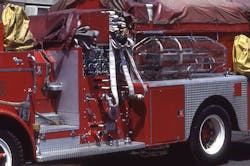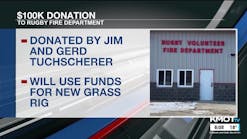Over the years, fire apparatus technology has advanced incrementally, largely due to electronic components that now monitor and control engines, transmissions, pump governors along with the entire vehicle operational parameters. Older generations of firefighters often lament the days when mechanical devices, such as relief valves and direct linkage discharge valves, were commonplace. However, time marches on with these changes, many of which improve the safety for our personnel. With all of these changes, a fire department’s history can still be an excellent predictor for future planning and strategic success.
Here, we’ll review how two departments—the career Harrisburg Bureau of Fire and the all-volunteer Colonial Park Fire Company, both in Pennsylvania—relied on history to influence the future.
Harrisburg Bureau of Fire
The City of Harrisburg is the capital of Pennsylvania and protected by the Bureau of Fire under the leadership of Chief Brian Enterline. The Bureau operates from three fire stations running two engines, two trucks and a squad company. Staffing for engines, trucks and squad are three personnel, with each of the engine companies and squad having a first-alarm district. In 2016, the Bureau responded to 2,681 incidents and 166 working fires.
At one time, Harrisburg operated two tractor-drawn aerial ladders, including a 1955 Mack B model equipped with an 85-foot Maxim ladder along with a 1967 American LaFrance 900 series 100-foot tiller. Beginning in 1971, the department placed into service its first of several Mack 75-foot tower ladders.
Due to the high level of fire activity, the tower ladders quickly gained favor, with their ability to position personnel rapidly for roof ventilation and exterior heavy-caliber streams. And over the next 30 years, the Harrisburg Bureau of Fire operated various models of tower ladders from different manufacturers. The durability of the Baker 75-foot tower was demonstrated when a 1989 model tower was rebuilt and installed on a 2008 Pierce Arrow XT tandem-axle chassis. This apparatus currently serves as Tower 1 assigned to the Allison Hill Station. Tower ladder operations were perfected, with units achieving optimum placement to utilize the platform to its maximum advantage.
Starting in 2010, the Bureau began the process to evaluate its truck company fleet that consisted of several model tower ladders ranging from 75-foot to 95-foot units. While the early model Mack CF single-axle towers featured short wheelbase chassis with excellent turning radius, later tandem-axle towers lacked this capability. The City of Harrisburg has many narrow streets with parking on either side of the road, as well as alleys that permit access to the rear of the buildings. With numerous rowhouses and wood-frame buildings, apparatus access and positioning is critical.
The decision was made to develop specifications for a tractor-drawn ladder that would enhance apparatus positioning and access, while providing additional body compartments and ground ladders. The result was the acquisition of a 2015 Pierce Arrow XT 100-foot ladder that is assigned as Truck 2. This vehicle has a tractor wheelbase of 160 inches with an overall length of 57 feet, 5 inches. The unit is equipped with 249 feet of ground ladders, including two 35-foot and two 24-foot extension ladders, along with a complement of roof ladders. The trailer was designed to have ground ladders mounted on each side of the trailer to permit rapid deployment. Truck 2 is equipped with a base section bed pipe for exterior streams along with a complement of hand tools and six ventilation saws.
The Bureau was able to compare the operational characteristics of its tower ladders and a tractor-drawn ladder from a neighboring department to evaluate the features of each style of aerial device.
In addition to the new Truck 2, the Bureau has recently placed into service Wagon 4, a 2017 Pierce Enforcer 1,500-gpm unit equipped with a 500-gallon low-profile water tank, with a short 181.50-inch wheelbase. Wagon 4 carries six preconnected crosslay attack lines ranging in length from 200 to 250 feet, with three lines coming off each side. A bumper-mounted 1¾-inch attack line is 150 feet long, with the rear hosebed outfitted with 1¾-inch, 2-inch and 2½-inch attack lines, each 300 feet long. The hosebed also carries 1,200 feet of 5-inch hose, two 300-foot 3-inch static beds and 200 feet of 3-inch hose to supply a portable step gun.
Chief Enterline and his members have done a remarkable job in designing these two new units, which feature multiple attack lines and well-outfitted body compartments with tool-mounting conducted by Specialized Fire Equipment in Middletown, PA. The Harrisburg Bureau of Fire was able to utilize not only technology but also the organization’s history to advance and improve its apparatus fleet.
Colonial Park Fire Company
In some instances, history does repeat itself, whether by design or the result of previous success stories that are passed along over the years.
The evolution of the rescue engine can be traced back at least four decades, as evidenced by the apparatus fleet history of the Colonial Park Fire Company. This organization was formed in February 1944 by several local citizens who were Air Raid Wardens during World War II. While this part of Lower Paxton Township was rural in nature, fire protection was very limited, and by August of that year, the department placed into service a second hand chemical wagon. Department members modified the vehicle with a pump and a water tank, which served the community for several years before the first new engine was acquired in 1951.
In 1986, Colonial Park placed into service its first rescue engine, which featured a Hahn four-door cab chassis with bodywork by Saulsbury Fire Equipment. Much was learned from operating this apparatus, which was replaced by a 2000 Spartan Gladiator chassis with a rescue-style body by KME Fire Apparatus.
Today, the department is under the command of Chief John Fogg III and responds to more than 600 incidents each year. The newest unit in the fleet is the third generation of rescue engines, with many features to enhance the operational safety for all personnel. Rescue Engine 33 is a 2017 KME Predator equipped with a Hale DSD model 1,500-gpm pump and 400-gallon water tank. This apparatus was specifically designed to carry all the rescue tools and basic engine company equipment. Rescue Engine 33 is outfitted with six Amkus hydraulic hose reels, a Harrison 15-kW generator, a light tower and 30-gallon Class B foam system.
The apparatus is built with a 208-inch wheelbase with an overall length of 34 feet, 10 inches. The aluminum body has seven body compartments with a fully enclosed pump panel. Three preconnected attack lines are carried in speedlay hose trays, with a 200-foot, 1¾-inch line carried in the front bumper. The rear hosebed is protected by an aluminum tread plate sliding hosebed cover and carries a 5-inch supply line.
Final thoughts
The evolution of fire apparatus design is partially driven by nationally accepted standards and the impact of governmental regulations. Additionally, there is a distinct regional influence of apparatus, which is driven, in part, by larger fire departments and what styles of apparatus they operate to protect their communities. Many years back, the Harrisburg blitz box was developed locally out of need to improve the attack line capabilities of engines that were acquired during the 1950s. Fabricated of plywood with six hosebeds for both 1½- and 2 ½-inch attack lines, using each of the pump panel discharges enabled a standard configuration pumper to be adapted for heavy fire duty. Today’s engine apparatus are designed with multiple attack lines based upon the utilization and fireground success of this design.
History can be an excellent predictor of the future. A close study of your fire department’s apparatus fleet history, along with a strong background of hands-on training, can greatly influence and improve your next apparatus acquisition.






